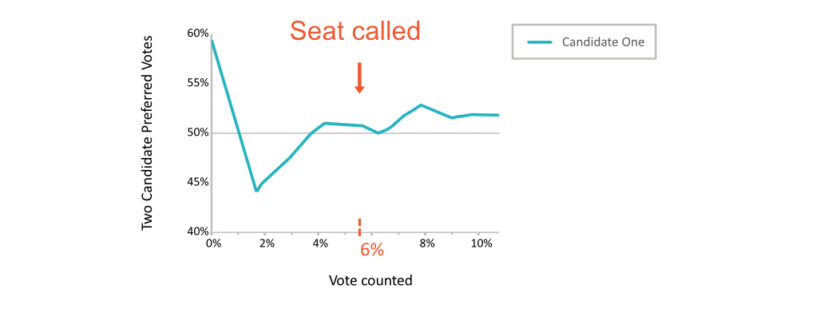How can they call a seat with under 6% of the vote counted on election night?
This interesting question was sent in by a follower, and having never given it much thought before, here’s what I found out. Read on or watch my video below to learn more.
The ABC’s election guru, Antony Green, runs the ABC results room on election night. You can check out his 30 min video “Election Night Analysis – Art or Science?”, where he covers some of the process behind calling a seat early. I had to dig a little deeper to discover the secrets behind this though!
Predictions focus on the two-candidate preferred (2CP) data.
- First they compute the 2CP swing since the last election for all polling booths that have phoned in their results so far.
- This current swing is added to the final 2CP seat result from the previous election.
- The prediction is updated every 2 minutes to include more polling booths as they become available.
Predicting results for Braddon – an example
Let’s assume Abbotsham polling booth in Braddon phones through their results first.

Let’s add a second polling booth – Acton.

Does Antony Green call the seat in favour of the Liberal candidate after two booths are counted? No. Two conditions need to be met first.
- Condition 1: At least 3% of the vote in the electorate is counted
- Condition 2: Predicted value higher than the 99% confidence interval around 50%
What does this mean? They want to be very confident that the candidate has MORE than 50% of the vote before calling the seat. We’ve already seen the predicted result for the Liberal candidate move around from 46.9% to 55.9% (and it next moves to 51.5%). The team waits for more results until they are sure the value won’t dip back under 50%. A 99% confidence interval assists in doing this.
(Remember that when you toss a coin 10 times you don’t always get exactly 5 heads, even though you have a 50% chance of tossing a head. We aren’t surprised if only 4/10 or 7/10 are heads. However, if 70/100 are heads then we will be pretty confident that the coin is weighted to more than 50% for heads. The ABC “calls the seat” when the prediction is high enough, and sufficient votes have been counted, that they are extremely confident the candidate’s result will stay above 50%.)
Let’s keep counting booths and see the two conditions in action in this graph. Here the seat would be called to the Liberal candidate with less than 6% of the vote counted. (The 17th booth is a large one.)

Days or weeks later, after all the postal and pre-poll votes are counted too, the final result was 53.09% to the Liberal candidate.
Why does predicting with the swing work?
- People tend to vote at the same polling booths and with the same two-candidate preferences.
- Preferences in small booths can tend to a different candidate than those from larger booths. The same for regional booth preferences tending to be different to urban booth preferences in the same seat. BUT the swing is fairly consistent across all these booths.
- The swing moves around less than the full vote count. By waiting until 3% of the vote is counted the prediction with the swing is fairly stable.

Does caution need to be taken with these predictions?
Yes. With more and more voters choosing to postal vote or pre-poll, the prediction can be less accurate. The ABC adds more variance to their predictions to account for this, which means they wait a little longer before calling the seat.
Can we stop watching the election coverage at 7:30pm?
Yes. The ABC’s method can tell you the final lower house result by 7:30pm on election night — if it can be called that night!
What data was used in this article?
Election data is publicly available here. It does not include a time stamp on when booths finished counting, which is why I had to assume the booths that were counted first.
Want to learn more from Simplify Stats?
Check out my upcoming courses, including “Intro to Stats – without the maths”. Data coaching is also available.
